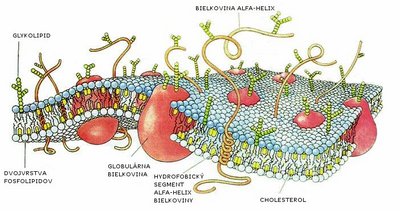Cell membrane
|
|
A component of every biological cell, the selectively permeable cell membrane (or plasma membrane or plasmalemma) is a thin and structured bilayer of phospholipid and protein molecules that envelopes the cell. It separates a cell's interior from its surroundings and controls what moves in and out. Cell surface membranes often contain receptor proteins and cell adhesion proteins. There are also other proteins with a variety of functions. These membrane proteins are important for the regulation of cell behavior and the organization of cells in tissues.
In animal cells, the cell membrane establishes this separation alone, whereas in yeast, bacteria and plants an additional cell wall forms the outermost boundary, providing primarily mechanical support. The plasma membrane is only about 10 nm thick and may be discerned only faintly with a transmission electron microscope. One of the key roles of the membrane is to maintain the cell potential.
| Contents |
A Fluid Mosaic
The basic composition and structure of the plasma membrane is the same as that of the membranes that surround organelles and other subcellular compartments. The foundation is a phospholipid bilayer, and the membrane as a whole is often described as a 'fluid mosaic' - a two-dimensional fluid of freely diffusing lipids, dotted or embedded with proteins which may function as channels or transporters across the membrane, or as receptors. Some of these proteins simply adhere to the membrane (extrinsic or peripheral proteins), while others might be said to reside within it or to span it (intrinsic proteins -- more at integral membrane protein). Glycoproteins have carbohydrates attached to their extracellular domains. Cells may vary the variety and the relative amounts of different lipids to maintain the fluidity of their membranes despite changes in temperature. Cholesterol molecules (in case of eukaryotes) or hopanoids (in case of prokaryotes) in the bilayer assist in regulating fluidity.
Detailed Structure
In fact, not all lipid molecules in the cell membrane are "fluid," in the sense of free to diffuse. Lipid rafts and caveolae are examples of more cohesive membrane regions. Across the membrane globally, also many proteins are not entirely free to diffuse. The cytoskeleton undergirds the cell membrane and provides anchoring points for integral membrane proteins. Anchoring restricts them to a particular cell face or surface--for example, the "apical" surface of epithelial cells that line the vertebrate gut--and limits how far they may diffuse within the bilayer. Finally, rather than presenting always a formless and fluid contour, the plasma membrane surface of cells may show structure. Returning to the example of epithelial cells in the gut, the apical surfaces of many such cells are dense with involutions, all similar in size. The finger-like projections, called "microvilli", increase cell surface area and facilitate the absorption of molecules from the outside. Synapses are another example of highly structured membrane.
Transport across membranes
As a lipid bilayer, the cell membrane is selectively permeable. This means that only some molecules can pass unhindered in or out of the cell. These molecules are either small or lipophilic. Other molecules can pass in or out of the cell, if there are specific transport molecules.
Depending on the molecule, transport occurs by different mechanisms, which can be separated into those that do not consume energy in the form of ATP (passive transport) and those that do (active transport):
Passive transport
Passive transport is a means of moving different chemical substances across membranes through diffusion of hydrophobic (non polar) and small polar molecules, or facilitated diffusion of polar and ionic molecules, which relies on a transport protein to provide a channel or bind to specific molecules. This spontaneous process decreases free energy, and increases entropy in a system. Unlike active transport, this process does not involve chemical energy (ATP).
Active transport
Typically moves molecules against their electrochemical gradient, a process that would be entropically unfavorable were it not stoichiometrically coupled with the hydrolysis of ATP. This coupling can be either primary or secondary. In the primary active transport, transporters that move molecules against their electrical/chemical gradient, hydrolyze ATP. In the secondary active transport, transporters use energy derived from transport of another molecule in the direction of their gradient, to move other molecules in the direction against their gradient. This can be either symport (in the same direction) or antiport (in the opposite direction). See also: active transport.
Examples include:
- endocytosis
- exocytosis, in which molecules packaged in membrane vesicles are either imported or exported, respectively. Molecular exchangers, transporters and pumps represent other examples.
References
- R.R. Dogonadze, Z.D. Urushadze, "Investigation of the Electrochemical Processes on the Border of Division Electrolite-Biological Membrane", Dep. VINITI (No 3633-71), Moscow, 1971, 20 pp. (In Russian)
- Z.D. Urushadze, "The Charge Transfer Across the Model Biological Membrane".- Proceedings of the Georgian Academy of Sciences, Series of Biology, 12, No 5, 1986, pp. 347-352 (In Russian, English summary)
External links
- Lipids, Membranes and Vesicle Trafficking - The Virtual Library of Biochemistry and Cell Biology (http://www.biochemweb.org/lipids_membranes.shtml)da:Cellemembran
de:Zellmembran es:Membrana celular is:Frumuhimna it:Membrana cellulare he:קרום תא ms:Membran sel nl:Celmembraan ja:細胞膜 pl:Błona komórkowa pt:Membrana celular sk:Cytoplazmatická membrán sl:Celična membrana zh:细胞膜

